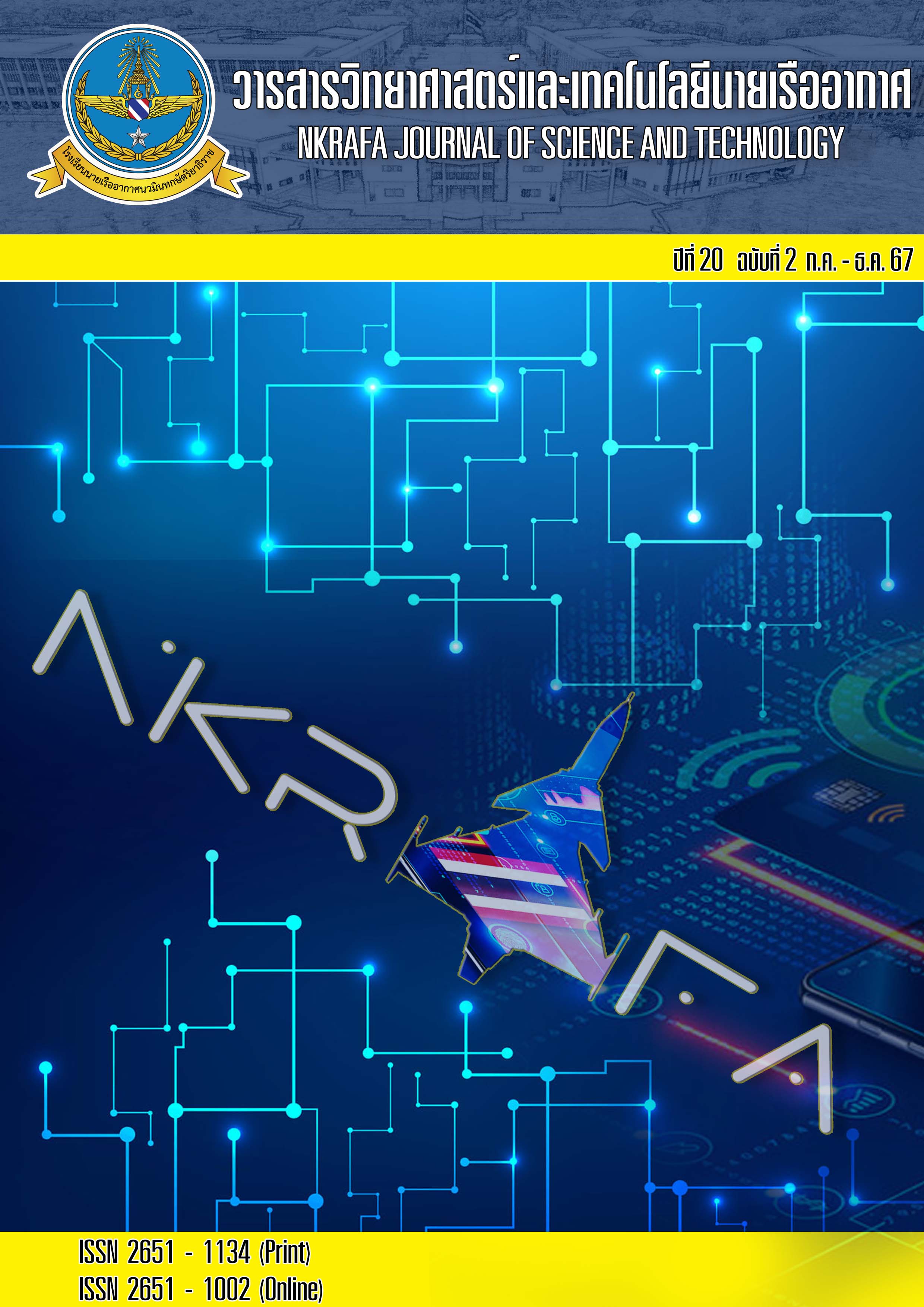Analyzing and Evaluating Aircraft Prediction Models based on Automatic Targets with Unidentified Orientation Data
Main Article Content
Abstract
The aircraft prediction model has been developed to identify the type and model of aircraft based on unknown target data. This serves as a crucial factor in military strategic decision-making to gain a tactical advantage. The essential aircraft types encompass fighters, transporters, helicopters, and training aircraft. These aircraft types have the capability to cause harm and pose a threat to national security when identified as unidentified targets on radar screens of air defense radar systems within the Air Force. Each type of aircraft encompasses various models, each with distinct capabilities tailored for different mission profiles, such as long-range flight, cargo transport, bombing, attack, and reconnaissance. For this reason, effective air defense necessitates the accurate identification of aircraft types and models, enabling strategic decision-making for appropriate response strategies. Although there have been studies on constructing aircraft prediction models from past research, it was found that they primarily focused on predicting types or specific models of aircraft, revealing limitations in their practical application. Therefore, the aircraft prediction model is imperative to be considered based on methods that align with the requirements for identifying the type and model of aircraft. This research analyzes and evaluates aircraft prediction models using modern classification techniques, including Neural Network, Decision Tree, Random Forest, K-Nearest Neighbors, Support Vector Machine, Naïve Bayes, Adaptive Boosting, Gradient Boosting, and Stochastic Gradient Descent. The model evaluation is conducted through statistical metrics relevant to classification, such as Area under the ROC Curve, Classification Accuracy, Precision, Recall, and Matthews Correlation Coefficient. The findings indicate that the most suitable and effective models for practical application are those developed using Neural Network and Random Forest techniques, respectively.
Article Details

This work is licensed under a Creative Commons Attribution-NonCommercial-NoDerivatives 4.0 International License.
- Content and information in articles published in NKRAFA Journal of Science and Technology are comment and responsibility of authors of articles directly. Journal editorial do no need to agree or share any responsibility.
- NKRAFA Journal of Science and Technology Articles holds the copyright of the content, pictures, images etc. which published in it. If any person or agency require to reuse all or some part of articles, the permission must be obtained from the NKRAFA Journal of Science and Technology.
References
Cai, Yu, Dushhyanth Rajaram, and Dimitri N. Mavris. "Multi-mission multi-objective optimization in commercial aircraft conceptual design." AIAA Aviation 2019 Forum. 2019.
กองการบิน. “คู่มือการบินติดตามการเปลี่ยนแปลงทรัพยากรธรรมชาติและสิ่งแวดล้อม.” สำนักงานปลัดกระทรวงทรัพยาการธรรมชาติและสิ่งแวดล้อม. 2562.
Mancini, Andrea, Jacopo Zamboni, and Erwin Moerland. "A knowledge-based methodology for the initiation of military aircraft configurations." AIAA AVIATION 2021 FORUM. 2021.
P. Daungklang and R. Kruakao, “Models for automatic aircraft type prediction”, NKRAFA SCT, vol. 15, pp. 1–8, Dec. 2019.
P. Anchuen and N. Phisutthangkoon, “A Model of Fighter Aircraft Classification Based on Information of Unknown Target Using Artificial Neural Networks”, J Appl Res Sci Tech, vol. 21, no. 2, pp. 89–103, Nov. 2022.
พระราชบัญญัติว่าด้วยการปฏิบัติต่ออากาศยานที่กระทำผิดกฎหมาย พ.ศ. ๒๕๕๓
Mekruksavanich, Sakorn. "ระบบฐานข้อมูลเทคโนโลยีป้องกันประเทศ." Defence Technology Academic Journal 2.5 (2020): 4-15.
Khera, K. K. (2020). Air Defence Command-A Bold Test Case.
W. Petchmak, P. Daungklang and P. Anchuen, "Comparing Coverage Models of Radar: Evaluating Viewshed Against Ground Truth Detection," 2023 8th International STEM Education Conference (iSTEM-Ed), Ayutthaya, Thailand, 2023, pp. 1-4, doi: 10.1109/iSTEM-Ed59413.2023.10305727.
P. Uthansakul, P. Anchuen, M. Uthansakul and A. Ahmad Khan, "Estimating and Synthesizing QoE Based on QoS Measurement for Improving Multimedia Services on Cellular Networks Using ANN Method," in IEEE Transactions on Network and Service Management, vol. 17, no. 1, pp. 389-402, March 2020, doi: 10.1109/TNSM.2019.2946091
Riduwan, H. S. (2007). Pengantar Statistika Untuk Penelitian: Pendidikan. Sosial, Komunikasi Ekonomi, dan Bisnis, Alfabeta, bandung.
Li, Zewen, Fan Liu, Wenjie Yang, Shouheng Peng, and Jun Zhou. "A survey of convolutional neural networks: analysis, applications, and prospects." IEEE transactions on neural networks and learning systems (2021).
Costa, Vinícius G., and Carlos E. Pedreira. "Recent advances in decision trees: An updated survey." Artificial Intelligence Review 56, no. 5 (2023): 4765-4800.
Hu, Jianchang, and Silke Szymczak. "A review on longitudinal data analysis with random forest." Briefings in Bioinformatics 24.2 (2023): bbad002.
Bansal, Malti, Apoorva Goyal, and Apoorva Choudhary. "A comparative analysis of K-nearest neighbor, genetic, support vector machine, decision tree, and long short term memory algorithms in machine learning." Decision Analytics Journal 3 (2022): 100071.
Cervantes, Jair, et al. "A comprehensive survey on support vector machine classification: Applications, challenges and trends." Neurocomputing 408 (2020): 189-215.
Chen, Shenglei, et al. "A novel selective naïve Bayes algorithm." Knowledge-Based Systems 192 (2020): 105361.
Bahad, Pritika, and Preeti Saxena. "Study of adaboost and gradient boosting algorithms for predictive analytics." International Conference on Intelligent Computing and Smart Communication 2019: Proceedings of ICSC 2019. Springer Singapore, 2020.
Velthoen, Jasper, et al. "Gradient boosting for extreme quantile regression." Extremes 26.4 (2023): 639-667.
Liu, Yanli, Yuan Gao, and Wotao Yin. "An improved analysis of stochastic gradient descent with momentum." Advances in Neural Information Processing Systems 33 (2020): 18261-18271.
Demsar J, Curk T, Erjavec A, Gorup C, Hocevar T, Milutinovic M, Mozina M, Polajnar M, Toplak M, Staric A, Stajdohar M, Umek L, Zagar L, Zbontar J, Zitnik M, Zupan B (2013) Orange: Data Mining Toolbox in Python, Journal of Machine Learning Research 14(Aug): 2349−2353. Retrieved Feburary 2024, from https:// https://orangedatamining.com/


